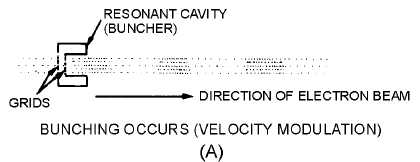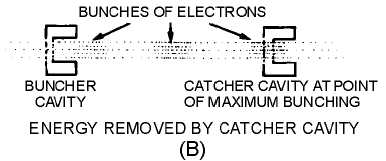2-9
maximum bunching to take useful energy from the beam (shown in figure 2-6B). The physical position of
the catcher cavity is determined by the frequency of the buncher-grid signal because this signal
determines the transit time of the electron bunches. Note also that both cavities are resonant at the
buncher-grid frequency. The electron bunches will induce an rf voltage in the grid gap of the second
cavity causing it to oscillate. Proper placement of the second cavity will cause the induced grid-gap
voltage to decelerate the electron bunches as they arrive at the gap. Since the largest concentration of
electrons is in the bunches, slowing the bunches causes a transfer of energy to the output cavity. The
balance of energy has been disturbed because the placement of the catcher cavity is such that bunches are
slowed down when they arrive at the cavity. The areas between bunches arrive at the cavity at just the
right time. At this time the voltage is of the correct polarity to increase the velocity of the electrons and
the beam absorbs energy. The areas between the bunches have very few electrons, so the energy removed
from the beam is much greater than the energy required to speed up the electrons between the bunches.
Therefore, if the second cavity is properly positioned, useful energy can be removed from a velocity-
modulated electron beam.
Figure 2-6A.—Removing energy from a velocity-modulated beam.
Figure 2-6B.—Removing energy from a velocity-modulated beam.
Q-5. The kinetic energy of an electron is directly proportional to what property?
Q-6. What will be the effect upon an electron traveling in the opposite direction to the lines of force in
an electrostatic field?
Q-7. How is a beam of electrons velocity-modulated?
Q-8. What portion of an electron gun causes the electrons to accelerate or decelerate?



